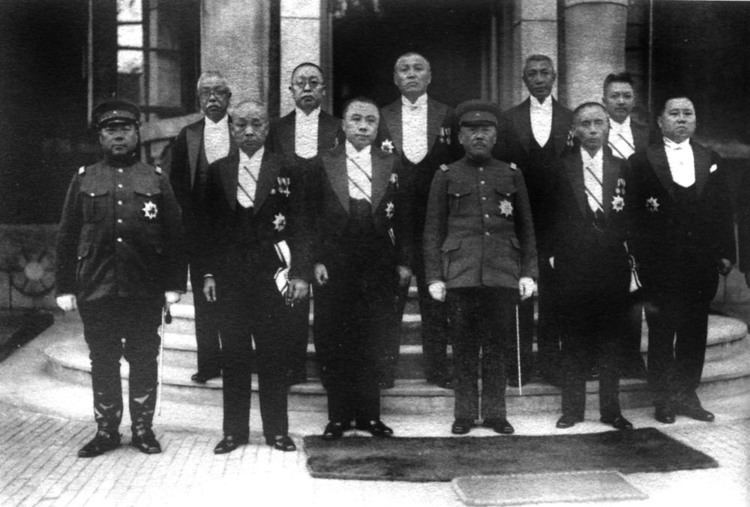Manchukuo was a puppet state set up by the Empire of Japan in Manchuria which existed from 1931 to 1945. The Manchukuo regime was established four months after the Japanese withdrawal from Shanghai with Puyi as the nominal but powerless head of state to add some semblance of legitimacy, as he was a former emperor and an ethnic Manchu.
Manchukuo was proclaimed a monarchy on 1 March 1934, with former Qing dynasty emperor Puyi assuming the Manchukuo throne under the reign name of Emperor Kang-de. An imperial rescript issued the same day, promulgated the organic law of the new state, establishing a Privy Council, a Legislative Council and the General Affairs State Council to "advise and assist the emperor in the discharge of his duties". The Privy Council was an appointive body consisting of Puyi's closest friends and confidants, and the Legislative Council was largely an honorary body without authority. The State Council was therefore the center of political power in Manchukuo.
Political parties and movements
During his administration, the Kangde Emperor, in an interview with foreign journalists, mentioned his interest in forming a political party with Confucian doctrines. The Japanese "native" establishment, however, organized some right-wing and nationalist parties, in the Militarism-Socialism mould. Such movements, which had official status, were:
Concordia Association (State-sponsored political party)Northeast Administrative Committee (Manchukuo nationalist local party)Russian Fascist Organization (the White Russian fascist association in Manchukuo)White Russian Fascist Party (later the Russian Fascist Party; White Russian anticommunist party in Manchukuo, used the swastika as symbol, guided by a Russian fascist "Duce")Bureau for Russian Emigrants in Manchuria (BREM) led by General Vladimir KislitsinMonarquic Party (White Russian Tsarist Monarchic party with Japanese approval)Betarim Jew Zionist Movement (Jewish rights movement in Manchukuo)Far Eastern Jewish Council (Jewish Zionist council in Harbin, Manchukuo led by Dr. Abraham Kaufman, with Japanese Army support)Aisin Gioro Henry Puyi (Kangde Emperor and head of state)Elizabeth Wanrong (Empress and first wife of the Kangde Emperor)Prince Aisin Gioro Pujie (brother of Puyi, possible heir of Manchukuo Throne)Prince Aisin Gioro Puren (brother of Puyi)Prince Aisin Gioro Yuyan (nephew of Puyi)Hiro Saga (Japanese sister-in-law of the Kangde Emperor)Wenxiu (first concubine of the Emperor)Tan Yuling (2nd Wife of the Kangde Emperor)Li Yuqin (4th Wife of the Kangde Emperor)Princess Aisin Gioro Huisheng (daughter of Pu-Chieh and Hiro Saga)Princess Aisin Gioro Xianyu (distant relative)Zheng Xiaoxu, prime ministerZhang Jinghui, next prime minister until 1945Xi Xia (Xi Qia), cabinet ministerMa Zhanshan, former warlord, and cabinet ministerXie Jishi, cabinet ministerZang Shiyi, cabinet ministerZhang Yangqing, cabinet ministerYu Zhishan, cabinet ministerYuan Jinkai, cabinet ministerLü Ronghuan, cabinet ministerDing Jianxiu, cabinet ministerLi Shaogeng, cabinet ministerRuan Zhenduo, cabinet ministerLing Sheng, cabinet ministerSun Qichang, cabinet ministerBao Guancheng, Manchukuo's first ambassador in TokyoYuan Cheng-Tse, Manchukuo ambassador in TokyoLi Shao-Keng, Manchukuo ambassador in TokyoGen. Tinge, Manchukuo diplomat in Tokyo(Commanders)
Shigeru Honjō (1 August 1931 – 8 August 1932)Nobuyoshi Mutō (8 August 1932 – 27 July 1933)Takashi Hishikari (29 July 1933 – 10 December 1934)Jirō Minami (10 December 1934 – 6 March 1936)Kenkichi Ueda (6 March 1936 – 7 September 1939)Yoshijirō Umezu (7 September 1939 – 18 July 1944)Otozō Yamada (18 July 1944 – 11 August 1945)(Chief of Staff)
Koji Miyake (10 August 1928 – 8 August 1932)Kuniaki Koiso (8 August 1932 – 5 March 1934)Juzo Nishio (5 March 1934 – 23 March 1936)Seishirō Itagaki (23 March 1936 – 1 March 1937)Hideki Tōjō (1 March 1937 – 30 May 1938)Rensuke Isogai (18 June 1938 – 7 September 1939)Jo Iimura (7 September 1939 – 22 October 1940)Heitarō Kimura (22 October 1940 – 10 April 1941)Teiichi Yoshimoto (10 April 1941 – 1 August 1942)Yukio Kasahara (1 August 1942 – 7 April 1945)Hikosaburo Hata (7 April 1945 – 11 August 1945)Chu Kudo, Chamberlain, aide-de-camp to Emperor PuyiChiune Sugihara, Vice Foreign MinisterHoshino Naoki, Vice Minister of FinanceKenji Doihara, Japanese spymaster and military commanderNorihiro Yasue, Army officer, author of the Fugu PlanKoreshige Inuzuka, Navy officer, co-author of the Fugu PlanMasahiko Amakasu, Vice Minister of Civil Affairs and head of Manchukuo Film AssociationYoshisuke Aikawa, prominent industrialistTatsunosuke Takasaki, prominent businessmanToranosuke Hashimoto, State Shinto head priestYanagida Genzo, Commander, Kwantung Defense CommandGenrikh Lyushkov, ex-Soviet Far East NKVD defector, adviser to Kwantung ArmyKonstantin Vladimirovich Rodzaevsky, White Russian anticommunist leaderGeneral Kislitsin, another White Russian anticommunist chiefAbraham Kaufman, founder of Far Eastern Jewish Council and Betarim Jew Zionists MovementTrebitsch Lincoln, Hungarian pro-Japanese collaboratorAugust Ponschab, German consul in Harbin, ManchuriaAuguste Ernest Pierre Gaspais, Vatican representative in Harbin, ManchuriaCharles Lemaire, Vatican diplomatic officer in Harbin, ManchuriaLian Yu, Nanjing Nationalist Government ambassador
